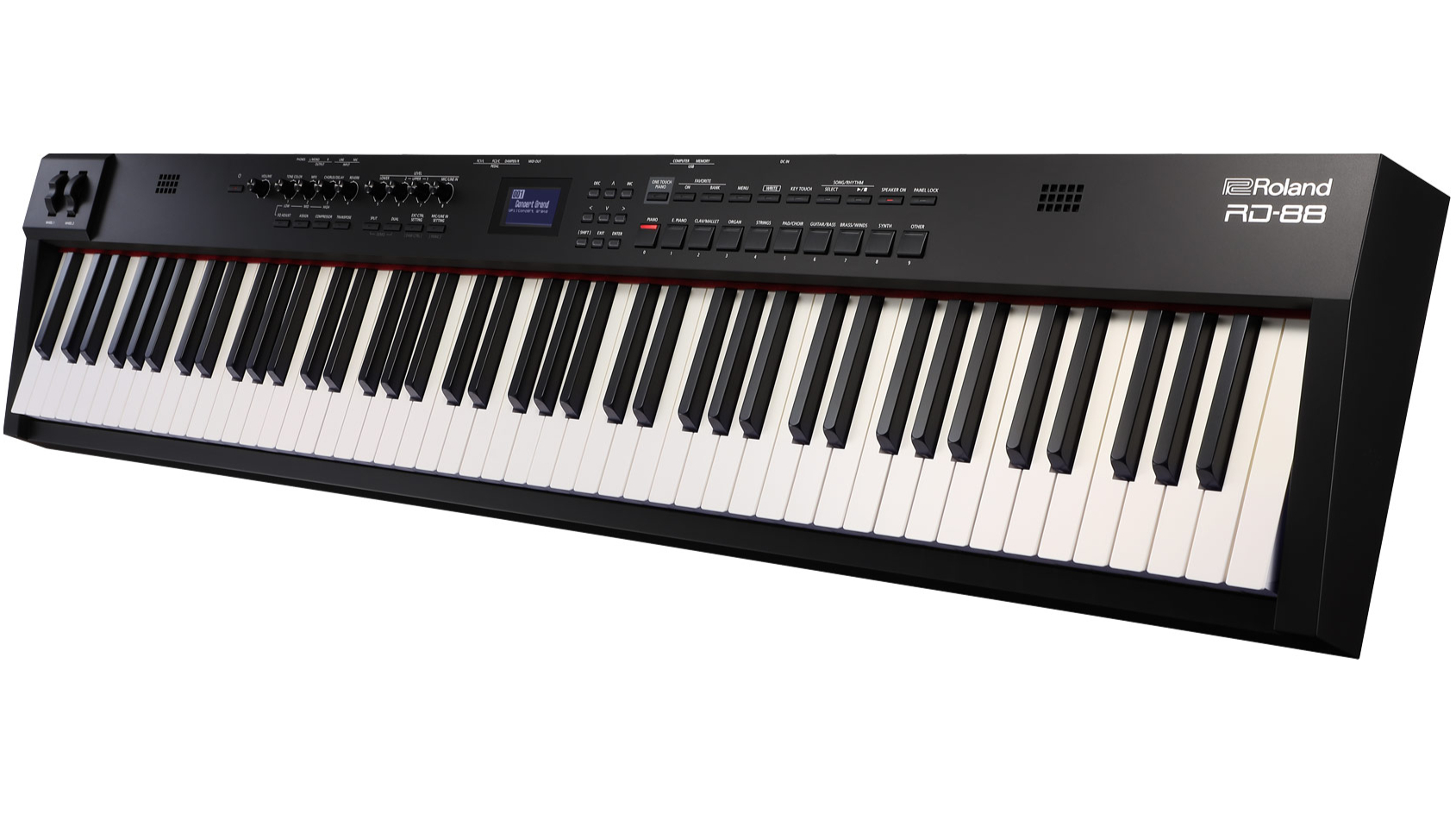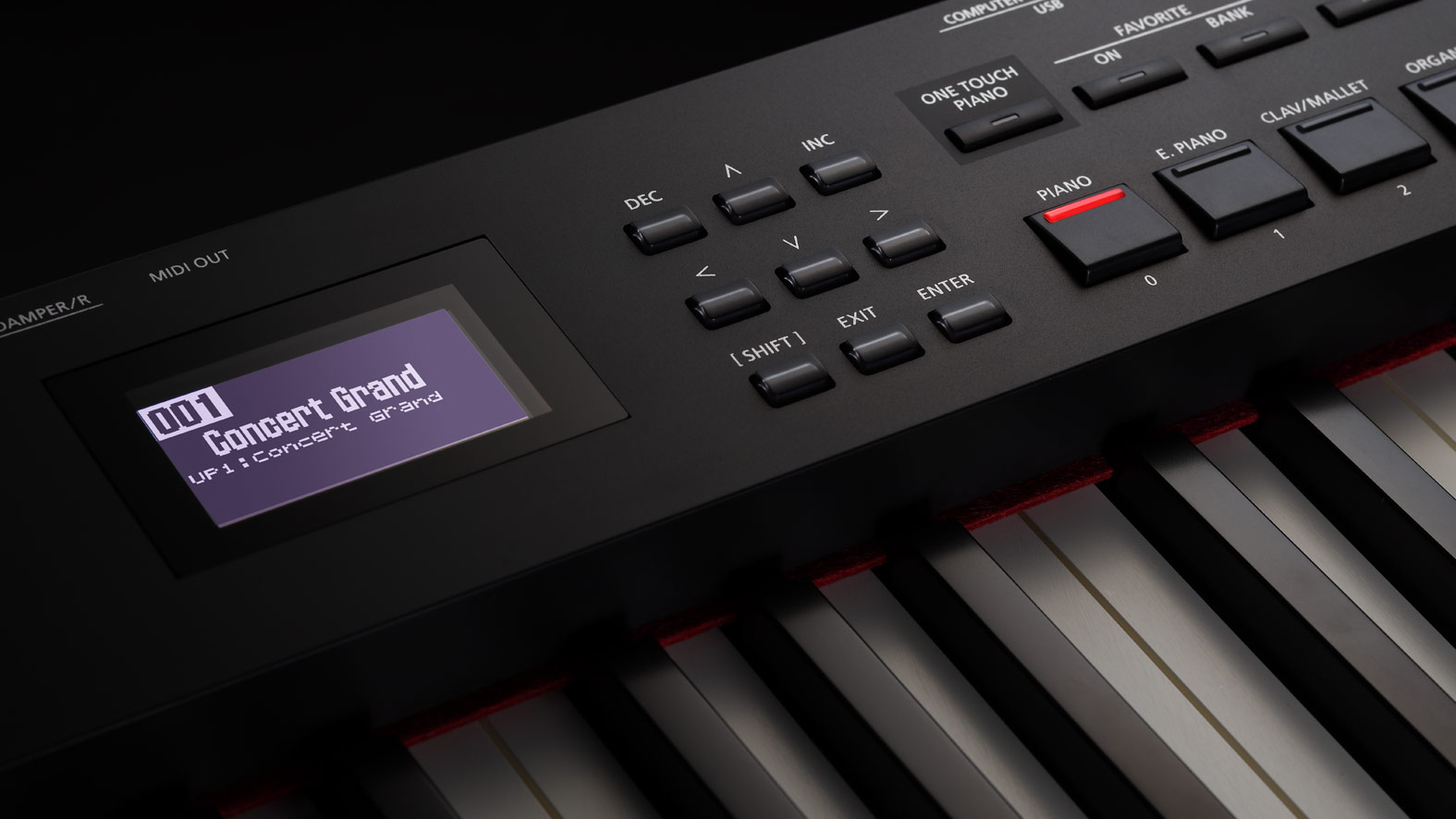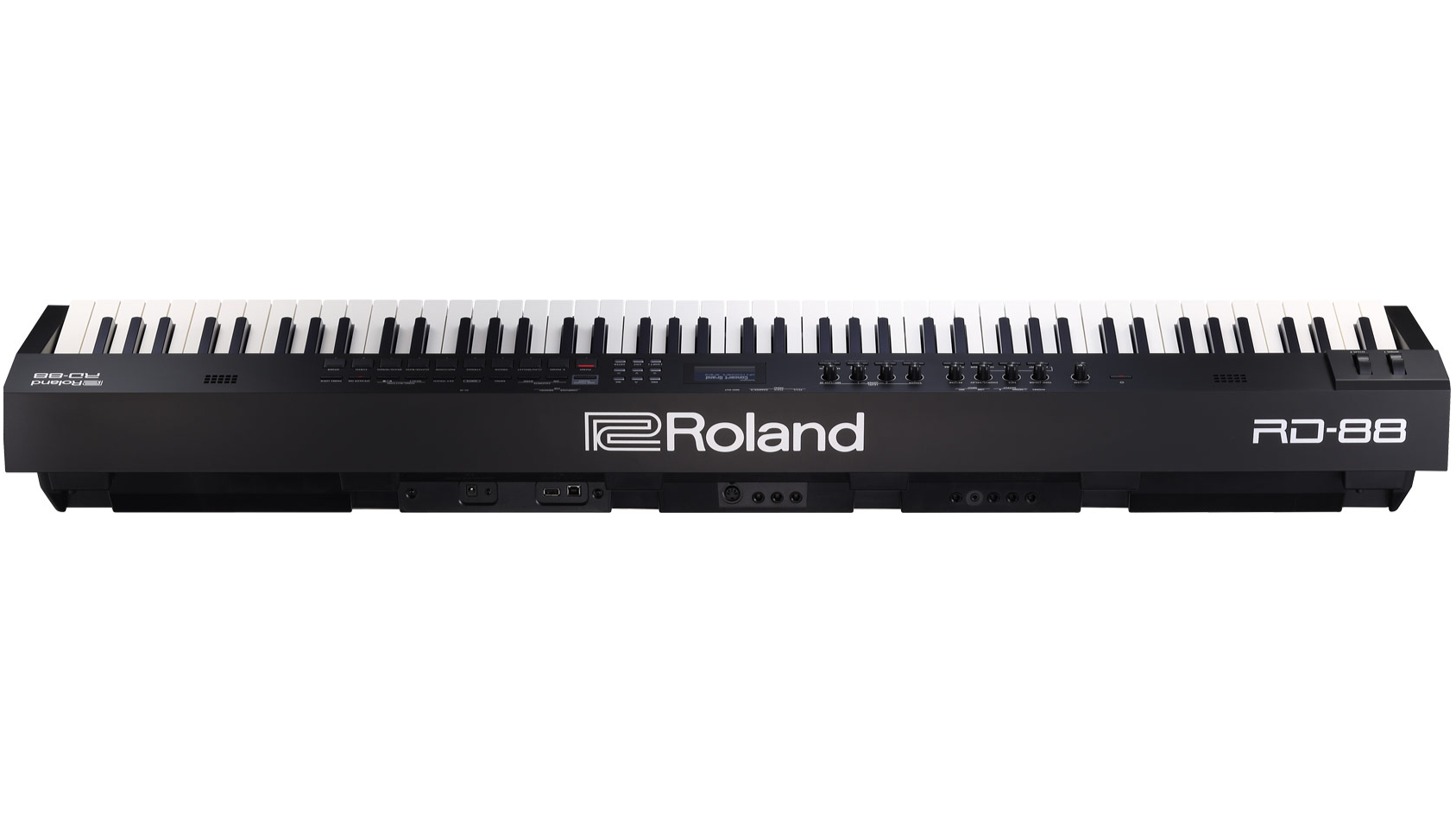MusicRadar Verdict
In terms of pianos, organs and other bread and butter sounds, the RD-88 more than has you covered - a deep and varied source of excellent sounds attached to a wonderful keyboard with all the connectivity and portability a gigging keyboard player might need.
Pros
- +
Loads of great sounds
- +
Compact and portable
- +
Great-feeling keyboard
- +
MainStage integration
Cons
- -
The screen is a bit small
- -
No jog wheel
- -
No XLR outputs
MusicRadar's got your back
Roland RD-88 review: What is it?
When it comes to stage pianos, Roland has a long and distinguished pedigree. Their first product in the RD line, the RD-1000, made its stage debut in 1986, and their current range consists of the flagship RD-2000 and the more compact and affordable RD-88, reviewed here, which is the lightest RD model that the company has made to date.
Stage pianos are a slightly different breed when compared to their domestic counterparts. Aimed at the professional and semi-pro gigging musician for use with a live band, they tend to be more portable and offer more onboard sounds than a domestic digital piano, while featuring more connection options to enable them to be hooked up to amps, mixing desks and PA systems. The recipe for success in this particular corner of the piano marketplace then is a mix of great playability, portability and a wide selection of bread-and-butter sounds like acoustic pianos and electric pianos and organs. So with its 88 full-size weighted keys squeezed into an ultra-slim profile, how does the RD-88 measure up in this arena?
Roland RD-88 review: Performance and Verdict

At first glance, the RD-88 looks every inch a capable instrument, with a generous smattering of hardware controls arranged across a neat and compact frame. While the more expensive RD-2000 gets the premium, wood-hybrid PHA-50 keyboard action, the RD-88 gets the same PHA-4 keybed as that used in Roland's mid-range home and portable pianos, from the entry-level FP-10 portable right up to the more costly RP-701 and HP-702 home digital models.
This is certainly no bad thing, since the PHA-4 is one of the more playable mid-range digital piano actions that we've tried, reassuringly firm by default and progressively weighted heavier to lighter from left to right. Handily, the key weighting can be adjusted to suit more synth-style playing if required. The PHA-4 has been engineered to replicate the feel of a real piano complete with escapement action to allow for the rapid repetition of notes. Although most prospective RD-88 buyers are likely to be relatively more experienced on the keys, it plays really well with a natural feel that appeals both to beginners and more advanced players alike.
As befits an instrument aimed at the professional end of the market, there’s a satisfying array of connectors around the back of the RD-88. Although there are no balanced XLR outputs, you do get two 6.3mm L/R output jacks, a 6.3mm headphone jack, ports for microphone and line inputs, three pedal jacks (damper and two foot controllers), a regular old-school 5-pin MIDI Out port and two USB ports - one for connecting to a computer for MIDI and audio transmission and the other for updating the unit’s firmware and installing extra sounds via a USB thumb drive. There's also a DC input that accommodates the supplied external power supply.
All these rear ports are tucked away under a sort of recessed shelf that is presumably intended to provide a clean look from an audience’s perspective, but it does make them a bit difficult to access from the front.
On the panel

The front panel sports a decent array of hardware controls arranged neatly around a central monochrome, eight-line 1024 x 64-dot LED screen. Up in the top left corner of the RD-88 are a small yet robust pair of pitch bend and mod wheels that work well for the synth sounds, but are in a bit of an awkward position. We personally prefer our performance controls located a bit further within easy reach just to the left of the keyboard, although we recognise that this placement design has been used in order to maintain the instrument’s minimal footprint.
Want all the hottest music and gear news, reviews, deals, features and more, direct to your inbox? Sign up here.
A series of handy rotary encoders offer instant control over reverb and delay. These pots double up as EQ controls for low, high and mid, a really useful feature for quickly adjusting your sound to fit your surroundings. Alternatively, these can be assigned to control whatever you like, using the instrument's assign mode. Over to the right, a second set of four control knobs allow you to adjust levels of upper and lower parts as well as mic/line input levels. Taken together, these present a good range of real-time control options over the balance, tone and effect depth of your current sound, although they could do with being better illuminated for use on dimly-lit stages.
Located two underneath and two at either end of the keyboard, the built-in speakers put out a decent amount of volume despite their diminutive size. This is Roland’s first RD piano with speakers, and while we wouldn’t recommend using them for any sort of advanced sound design, it’s nice to have these for two reasons. They make it so that you can just switch on the RD-88 and play it, brilliant if you suddenly get inspired and don’t want to waste time hooking up a PA or computer. Secondly, even when connected to a PA system, it’s always nice to feel something coming back at you from an instrument, and these speakers fit the bill nicely in both scenarios.
Plug a dynamic mic into the mic input on the back and you can sing along to what you're playing, adding reverb and EQ as you go, although there's sadly no JUNO-X-esque vocoder feature present.
More sounds per pound

The RD-88 relies on Roland's renowned SuperNATURAL sound engine for its piano and electric piano sounds, while everything else is powered by the same Zen-Core technology that powers some of their current synthesizer models such as the JUPITER-X, JUNO-X and the new FANTOM-0 series. You'll find a generous selection of over 3000 preset tones on board, which are organised into over 400 scenes for instant recall on stage. If this doesn't go quite far enough, Roland Cloud subscribers have the option to download and install even more sounds.
A dedicated 'One-touch Piano' button gets you back to the concert grand piano sound with a single push, although this can be assigned to recall any other sound if you prefer. There's also a panel lock button to avoid any accidental patch changes occurring during a performance.

Korg D1: Ultra-affordable stage piano from Korg has only 30 sounds and no speakers, but features the brilliant RH3 keyboard action.
Casio PX-S3100: 700 tones and 200 rhythms are packed into what Casio claims to be the world’s slimmest digital piano. Casio’s Smart Scaled Hammer Action Keyboard, Bluetooth audio and Chordana play compatibility round off a solid package.
The onboard scenes are organised into ten broad categories - Piano, E Piano, Clav / Mallet, Organ, Strings, Pad / Choir, Guitar / Bass, Brass / Winds, Synth and Other. These are accessed via big, easily-hittable buttons, each illuminated with a red LED, and you can layer or split up to three sounds at once. Stepping through the sounds is achieved by diving directly into the categories with the category buttons and then pressing the ‘Inc’ button. With such a large sound palette to dip into, we feel that an encoder wheel like that found on the RD-2000 might be a helpful addition, rather than having to resort to the 'Inc' button and arrow keys to navigate through lengthy sound and parameter lists.
There are also 201 built-in rhythms to choose from, the last 11 of which are metronome settings in different time signatures. These are just drum beats without auto-accompaniment style features, useful for playing along to while practising.
In terms of the quality of the sounds, if you're a Roland fan, you'll find plenty to like here. The SuperNATURAL piano sounds are superb as usual - the concert grand features the normal Roland sparkly and bright character with the faintest hint of digitalness, which gives it the ability to punch through in a band environment. The electric pianos are equally rewarding, with the Rhodes tones, in particular, the 1975 E Piano 1 setting, delivering just the right amount of croak, thunk and squeak by default, although more or less of this can be dialled in as required.
Organ sounds are plentiful, although a slight issue we picked up on with these was that switching speaker spin speed from slow to fast was difficult to find at first. Our first choice for this would have been the mod wheel, but it turned out that this parameter was controlled by the MFX control for the majority of the organ sounds. We would probably end up assigning this to an optional foot pedal, and luckily almost all of the RD-88’s hardware controllers are assignable.
Being derived from the Zen-Core engine, the synth sounds are varied and satisfyingly complex, with plentiful searing leads, lush evolving pads and brash and bold polys. There's no dedicated software editor for the RD-88 though, so if you're a tweaker, you'll be limited to a relatively narrow range of editing options via the front screen.
Centre stage

One aspect of the RD-88’s feature set that can be singled out as fairly unique among its peers is its deep integration with Apple's MainStage software. Essentially Logic Pro without the sequencing bit, MainStage is a widely-used sound source within the live community.
Recognising this, the RD-88 has been designed to work in tandem with the software, permitting the selection and control of the sounds within Mainstage on your computer directly from the instrument's front panel. If you're a regular user of MainStage, this integration could be a game changer - you can layer and combine internal sounds from the RD-88 with sounds from MainStage for example, while using the RD-88’s rotary encoders to adjust the first eight parameters of your MainStage patch, with all pertinent information displayed on the RD-88’s screen - pretty nifty!
Final verdict

In terms of pianos, organs and other bread and butter sounds, the RD-88 more than has you covered - a deep and varied source of excellent sounds attached to a wonderful keyboard with all the connectivity and portability a gigging keyboard player might need.
Focussed on portability, its weight of only 13.5kg makes it remarkably luggable for a stage piano - your road crew and/or your lower vertebrae will thank you for purchasing this - and the MainStage integration is the icing on the cake. All in all, a very tempting package for the jobbing keys player.
Roland RD-88 review: Specifications
- Keys: PHA-4 keyboard with 88 individually weighted keys with escapement and synthetic ivory key tops
- Weight: 13.5kg
- Dimensions (W x D x H)mm: 1284 x 258 x 159
- Speakers: 2 x 6W
- Pedals: Roland DP-2 Damper, 2 x Assignable (not included)
- Connections: 1 x 6.3mm headphone output, 1 x 3.5mm headphone output, USB to host, USB to device
- Tones: 3000+
- Scenes: 400
- Contact: Roland
Dave has been making music with computers since 1988 and his engineering, programming and keyboard-playing has featured on recordings by artists including George Michael, Kylie and Gary Barlow. A music technology writer since 2007, he’s Computer Music’s long-serving songwriting and music theory columnist, iCreate magazine’s resident Logic Pro expert and a regular contributor to MusicRadar and Attack Magazine. He also lectures on synthesis at Leeds Conservatoire of Music and is the author of Avid Pro Tools Basics.
